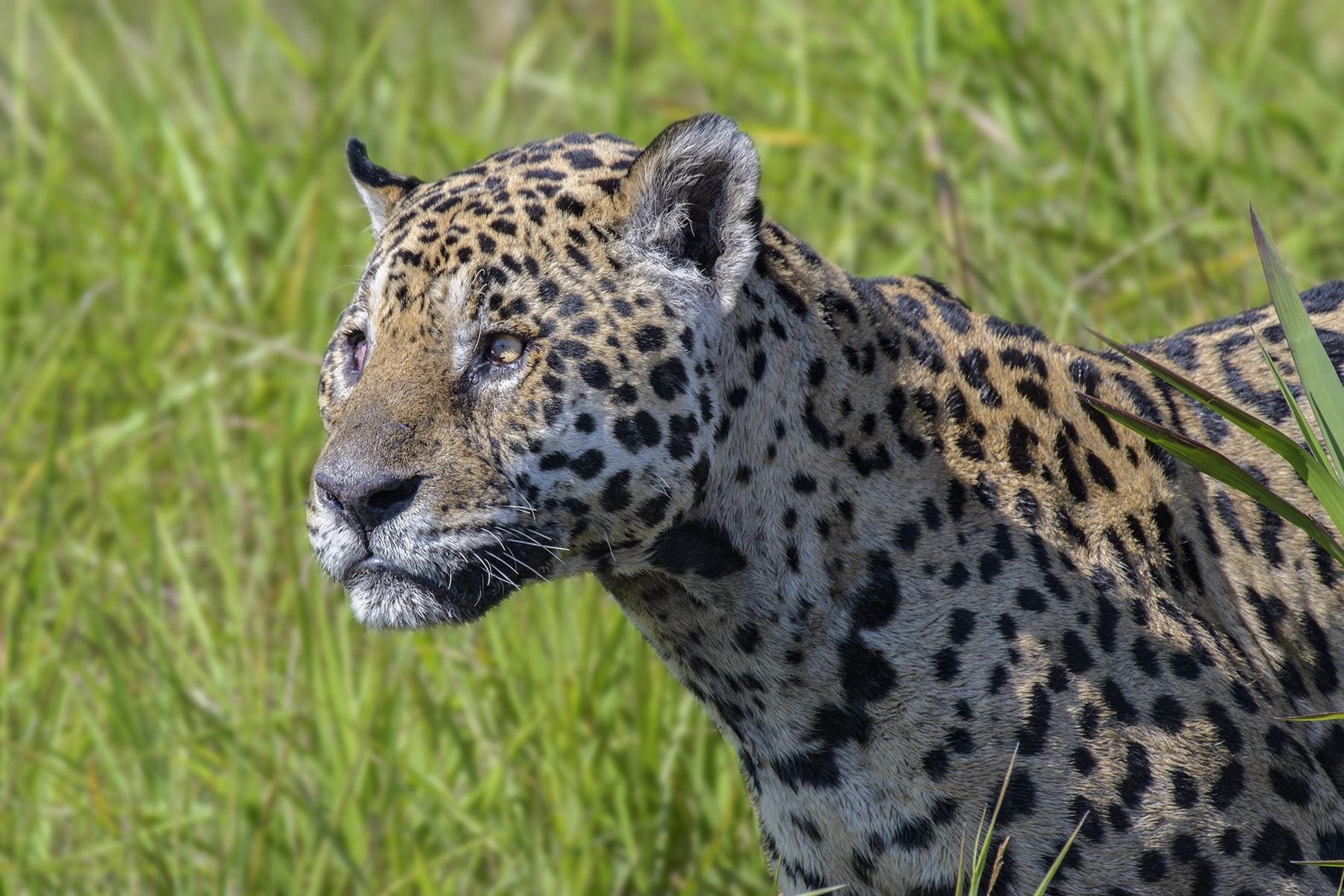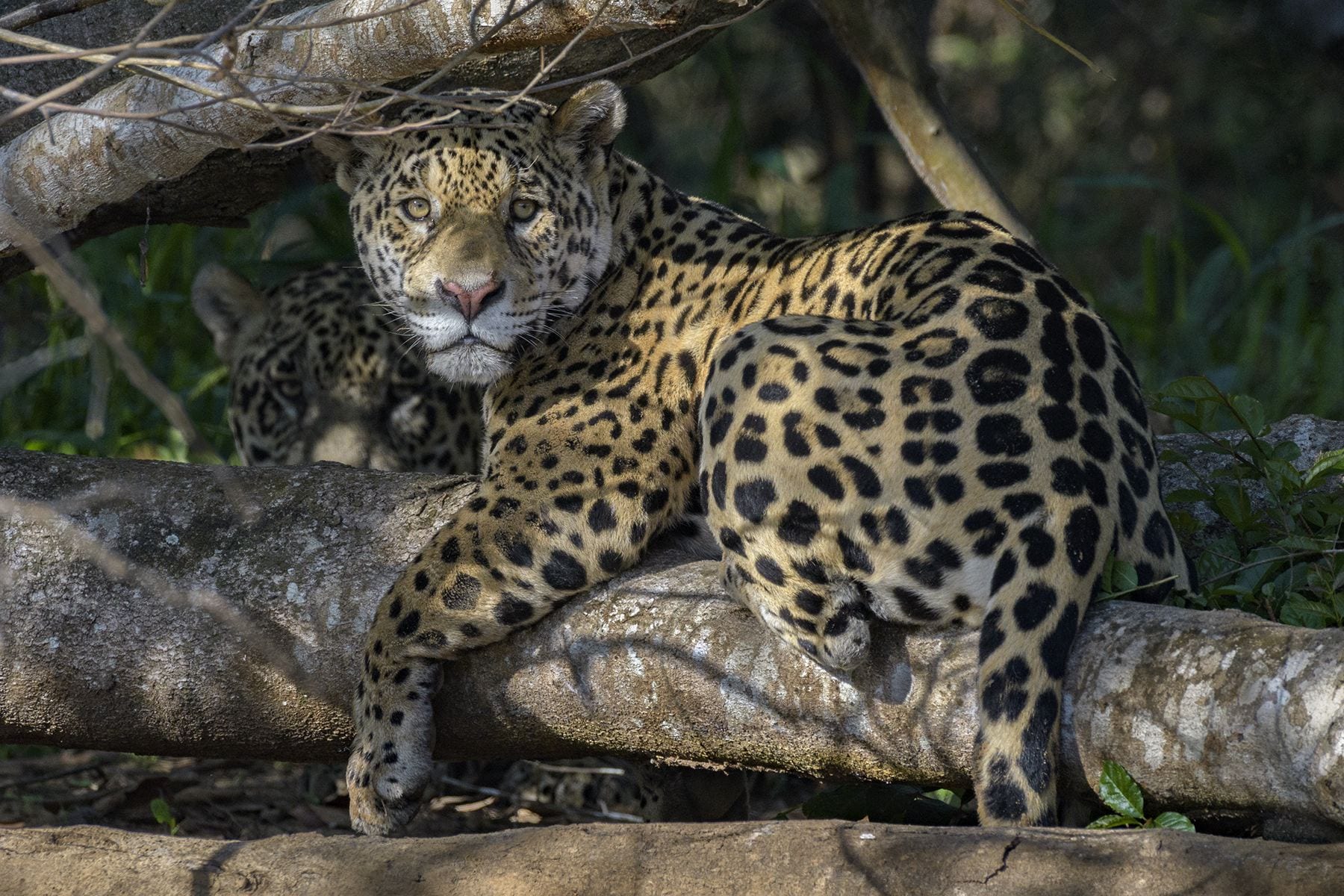After spending our first two days in the Pantanal roaming around grassy fields and wetlands, we moved on to Porto Jofre, where the southern end of the Transpantaneira Highway meets the Cuiabá River—and there we spent the better part of two days on boats on the river.

Wikipedia describes Porto Jofre as a “settlement,” which I guess is a few notches below a town or village. In an earlier post, I explained that the area once was primarily a destination for sport-fishing, and then about 12 years ago fishermen started seeing jaguars along the river; today, the jaguars are the big attraction. We stayed in a place that apparently got its start as a fishing camp, as evidenced by the accommodations: Each room had a barracks-like collection of four single beds in a row.
The routine at Porto Jofre was pretty straightforward: Get up around 4:30 am, breakfast at 5, pull your gear together and head to the dock by 6:15, get into the boats and go. We’d spend most of the morning out on the boats, come back for lunch, then go out on the river again at mid-afternoon and stay until the sun went down—which, because it’s winter in the Southern Hemisphere, came around 5 p.m. Then we’d come back to our rooms, download images, go to dinner, go to bed, get up in the morning, repeat.

I was curious to see what the priority would be for the boat trips: Jaguars? Or birds? Glenn had said we’d try to find some jaguars on our first day, to “get the monkey off our backs,” as he put it. The next day, he said, we’ll see who wants to continue photographing jaguars and who would rather concentrate on birds. We’d divide up accordingly and go out in two separate boats—a jaguar boat and a bird boat, essentially.
It may seem strange to you, but I really didn’t care whether we saw jaguars or not. I was there for the birds. Glenn said that that’s not uncommon on his trips—which are, after all, primarily about bird photography—but he also said that some people say they’re only interested in birds, then once they see and photograph jaguars, they get hooked on the big cats.
As it turns out, we saw a couple of jaguars the first day, and chased a few the second day as well. By “chased” I mean that we’d be in a boat at the edge of the river, trying to get photos of some interesting bird, when word of a jaguar sighting would come over the boat driver’s radio, and we’d abandon the bird photography and go speeding off to the jaguar. That was true on both days—we didn’t end up dividing up into groups according to interest after all—and I have to say I didn’t love it. It seemed like we’d repeatedly waste 20 minutes or more speed-boating to a reported jaguar sighting, only to get there and find that the jaguar had decided to lie down and sleep, or had just left. But that’s the thing with group travel, and travel generally: It requires flexibility, and I probably just need to get better at going with the flow.
And I will say that for every time we came up short in our efforts to see the jaguars, there was another time when we were rewarded with a memorable experience. The guy in the photo below, for example, walked along the river bank for a while, then stood in the open and looked around while we took photos like crazy:
He seemed a little grizzled, and Ricardo estimated him to be about 12 years old, I think; he said jaguars in the wild usually live to be 12 to 15. The guides call him Mick Jaguar.
On another occasion we had a chance to watch a pair of jaguars that had been mating, though by the time we got there they were just walking around. At one point they lay down in the woods near the water’s edge, and I got the image below of one of them looking right at us—or so I thought. When I processed it on the computer later, I realized there were two cats in the photo, and both were looking at us:
People ask me how close these big cats were to us. I’m not a good estimator of distances—maybe 30 yards or so?—but in any case we never felt threatened. We were in boats, and it just didn’t seem plausible that a jaguar would leap into one of our boats and take on a group of five or more humans. We were told that their diet is mostly caimans and capybaras.
 The photo at right, which I took with my iPhone, shows a typical gathering of boats when a jaguar has been spotted. Whichever boat gets there first positions themselves for the best viewing, and everyone else just falls in around them. Ricardo told us at the outset to be respectful of the people in the other boats, and we were. Apparently some tourists can be really badly behaved, and some guides don’t do enough to keep everyone in line, and as a result there can be heated arguments among the boats. Once in a while, as Greg Downing (another respected nature photographer) detailed in a Facebook post last year, tourists will actually get out of the boats and try to go on shore to see the jaguars up-close. Very stupid. But we experienced no problems—and everyone, including me, was happy to have seen such beautiful animals in the wild.
The photo at right, which I took with my iPhone, shows a typical gathering of boats when a jaguar has been spotted. Whichever boat gets there first positions themselves for the best viewing, and everyone else just falls in around them. Ricardo told us at the outset to be respectful of the people in the other boats, and we were. Apparently some tourists can be really badly behaved, and some guides don’t do enough to keep everyone in line, and as a result there can be heated arguments among the boats. Once in a while, as Greg Downing (another respected nature photographer) detailed in a Facebook post last year, tourists will actually get out of the boats and try to go on shore to see the jaguars up-close. Very stupid. But we experienced no problems—and everyone, including me, was happy to have seen such beautiful animals in the wild.
We did see some cool birds, giant river otters, and other animals in our two days along the river. More on that in the next post.


Hey Tina, I may have missed it in one of your earlier posts, but photographers out there might be interested in hearing snippets of what equipment you were using for some of the images. Sounds like a fair amount of hand holding going on other than tripod work at the lodges. Are you still using DSLR body? What was your primary walk around lens? Using the same lens for tripod work at the feeders? Also, even non-photographers might find a description of your luggage (and contents) decisions for traveling ‘on-the-road’ of interest. You know, the old desire to bring everything, until you lift the bags and realize you have to schlep the beasts through airports and buses.
That’s a good point—maybe I’ll do a post on that if time permits. Yes, everyone was shooting with DSLR bodies, and in general people seemed to use big prime lenses (e.g., 600mm) on tripods when they were around the lodges, and then when we were out on the boats, with no tripods or monopods, people were shooting hand-held with the Canon 100-400 or the Nikon 200-500 or thereabouts. My friend Elizabeth, who shoots Nikon, really likes the lightweight 300mm f/4 PF lens with a 1.4 teleconverter on it; I think she used that heavily throughout the trip. Glenn Bartley impressed the heck outta me by using some sort of Canon crop-sensor body with a 600mm prime and a 1.4 TC—and hand-holding the whole thing.